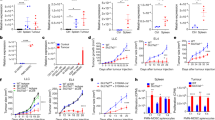Abstract
The COX-2 product prostaglandin E2 (PGE2) contributes to the high metastatic capacity of breast tumors. Our published data indicate that inhibiting either PGE2 production or PGE2-mediated signaling through the PGE2 receptor EP4 reduces metastasis by a mechanism that requires natural killer (NK) cells. It is known that NK cell function is compromised by PGE2, but very little is known about the mechanism by which PGE2 affects NK effector activity. We now report the direct effects of PGE2 on the NK cell. Endogenous murine splenic NK cells express all four PGE2 receptors (EP1-4). We examined the role of EP receptors in three NK cell functions: migration, cytotoxicity, and cytokine release. Like PGE2, the EP4 agonist PGE1-OH blocked NK cell migration to FBS and to four chemokines (ITAC, MIP-1α, SDF-1α, and CCL21). The EP2 agonist, Butaprost, inhibited migration to specific chemokines but not in response to FBS. In contrast to the inhibitory actions of PGE2, the EP1/EP3 agonist Sulprostone increased migration. Unlike the opposing effects of EP4 vs. EP1/EP3 on migration, agonists of each EP receptor were uniformly inhibiting to NK-mediated cytotoxicity. The EP4 agonist, PGE1-OH, inhibited IFNγ production from NK cells. Agonists for EP1, EP2, and EP3 were not as effective at inhibiting IFNγ. Agonists of EP1, EP2, and EP4 all inhibited TNFα; EP4 agonists were the most potent. Thus, the EP4 receptor consistently contributed to loss of function. These results, taken together, support a mechanism whereby inhibiting PGE2 production or preventing signaling through the EP4 receptor may prevent suppression of NK functions that are critical to the control of breast cancer metastasis.





Similar content being viewed by others
Explore related subjects
Discover the latest articles and news from researchers in related subjects, suggested using machine learning.References
Su Y, Huang X, Raskovalova T, Zacharia L, Lokshin A, Jackson E, Gorelik E (2008) Cooperation of adenosine and prostaglandin E2 (PGE2) in amplification of cAMP-PKA signaling and immunosuppression. Cancer Immunol Immunother 57:1611–1623
Su Y, Jackson E, Gorelik E (2010) Receptor desensititzation and blockade of the suppressive effects of prostaglandin E2 and adenosine on the cytotoxic activity of human melanoma-infiltrating T lymphocytes. Cancer Immunol Immunother [Epub ahead of print]
Kundu N, Ma X, Holt D, Goloubeva O, Ostrand-Rosenberg S, Fulton A (2009) Antagonism of the prostaglandin E receptor EP4 inhibits metastasis and enhances NK function. Breast Cancer Res Treat 117:235–242
Kundu N, Walser T, Ma X, Fulton A (2005) Cyclooxygenase inhibitors modulate NK activities that control metastatic disease. Cancer Immunol Immunother 54:981–987
Maghazachi A (2003) G protein-coupled receptors in natural killer cells. J Leukoc Biol 74:16–24
Martinet L, Jean C, Dietrich G, Fournie J, Poupot R (2010) PGE2 inhibits natural killer and γδ T cell cytotoxicity triggered by NKR and TCR through a cAMP-mediated PKA type I-dependent signaling. Biochem Pharmacol 80:838–845
Serezani C, Ballinger M, Aronoff D, Peters-Golden M (2008) Cyclic AMP master regulator of innate immune cell function. Am J Respir Cell Mol Biol 39:127–132
Brunda MJ, Herberman RB, Holden HT (1980) Inhibition of murine natural killer cell activity by prostaglandin. J Immunol 124:2682–2687
Sugimoto Y, Narumiya S (2007) Prostaglandin E receptors. J Biol Chem 282:11613–11617
Kabashima K, Sakata D, Nagamachi M, Miyachi Y, Inaba K, Narumiya S (2003) Prostaglandin E2-EP4 signaling initiates skin immune responses by promoting migration and maturation of Langerhans cells. Nat Med 9:744–749
Legler D, Krause P, Scandella E, Singer E, Groettrup M (2006) Prostaglandin E2 is generally required for human dendritic cell migration and exerts its effect via EP2 and EP4 receptors. J Immunol 176:966–973
von Adrian U (2001) PKC-β(I): the whole ignition system or just a sparkplug for T cell migration? Nat Immunol 2:477–488
Ma X, Kundu N, Rifat S, Walser T, Fulton A (2006) Prostaglandin E receptor EP4 antagonism inhibits breast cancer metastasis. Cancer Res 66:2923–2927
Ma X, Kundu N, Ioffe O, Goloubeva O, Konger R, Baquet C, Gimotty P, Reader J, Fulton A (2010) Prostaglandin E receptor EP1 suppresses breast cancer metastasis and is linked to survival differences and cancer disparities. Mol Cancer Res 8:1310–1318
Zeddou M, Greimers R, de Valensart N, Nayjib B, Tasken K, Boniver J, Moutschen M, Rahmouni S (2005) Prostaglandin E2 induces the expression of functional inhibitory CD94/NKG2A receptors in human CD8 + T lymphocytes by a cAMP-dependent protein kinase A type I pathway. Biochem Pharmacol 70:714–724
O’Callaghan G, Kelly J, Shanahan F, Houston A (2008) Prostaglandin E2 stimulates fas ligand expression via the EP1 receptor in colon cancer cells. Br J Cancer 99:502–512
Joshi P, Zhou X, Cuchens M, Jones Q (2001) Prostaglandin E2 suppressed IL-15-mediated human NK cell function through down-regulation of common γ-chain. J Immunol 166:885–891
Boniface K, Bak-Jensen K, Li Y, Blumenschein W, McGeachy M, McClanahan T, McKenzie B, Kastelein R, Cua D, de Waal Maefyt R (2009) Prostaglandin E2 regulates Th17 cell differentiation and function through cyclic AMP and EP2/EP4 receptor signaling. J Exp Med 206:535–548
Murase A, Taniguchi Y, Tonai-Kachi H, Nakao K, Takada J (2008) In vitro pharmacological characterization of CJ-042794, a novel, potent, and selective prostaglandin EP4 receptor antagonist. Life Sci 82:226–232
Ratcliffe M, Walding A, Shelton P, Flaherty A, Dougall I (2007) Activation of E-prostanoid-4 and E-prostanoid-2 receptors inhibits TNF-α release from human alveolar macrophages. Eur Respir J 29:986–994
Spaziani E, Benoit R, Tsibris J, Gould S, O’Brien W (1998) Tumor necrosis factor-alpha upregulates the prostaglandin E2 EP1 receptor subtype and the cyclooxygenase-2 isoform in cultured amnion WISH cells. J Interferon Cytokine Res 18:1039–1044
Acknowledgments
This study was supported by grant support from United States Department of Health and Human Services, United States Department of Defense, and the United States Department of Veteran Affairs.
Author information
Authors and Affiliations
Corresponding author
Rights and permissions
About this article
Cite this article
Holt, D., Ma, X., Kundu, N. et al. Prostaglandin E2 (PGE2) suppresses natural killer cell function primarily through the PGE2 receptor EP4. Cancer Immunol Immunother 60, 1577–1586 (2011). https://doi.org/10.1007/s00262-011-1064-9
Received:
Accepted:
Published:
Issue Date:
DOI: https://doi.org/10.1007/s00262-011-1064-9




